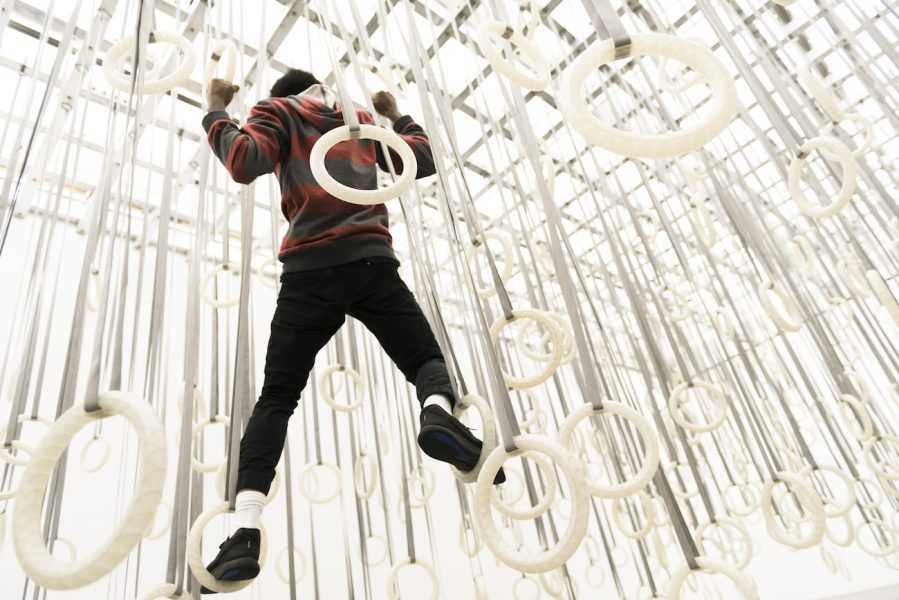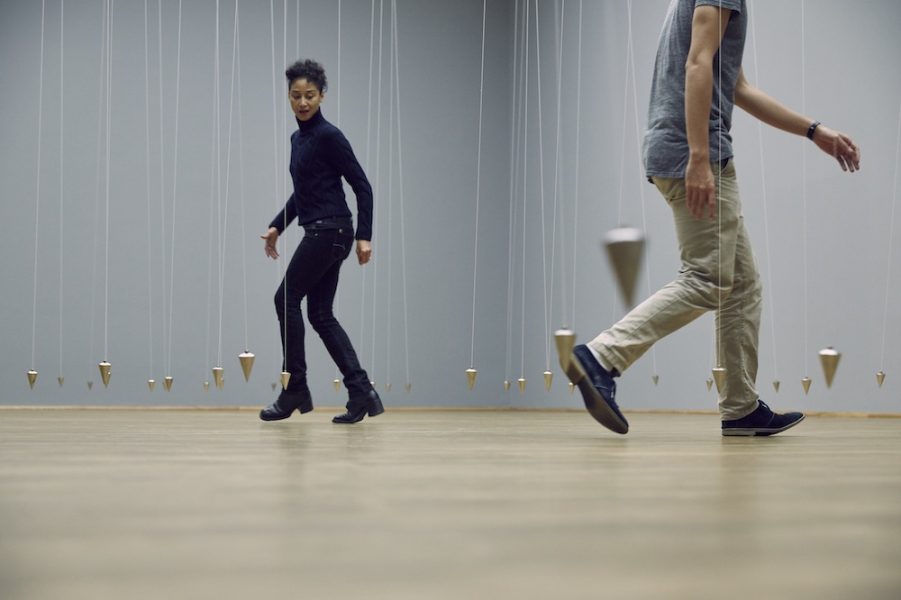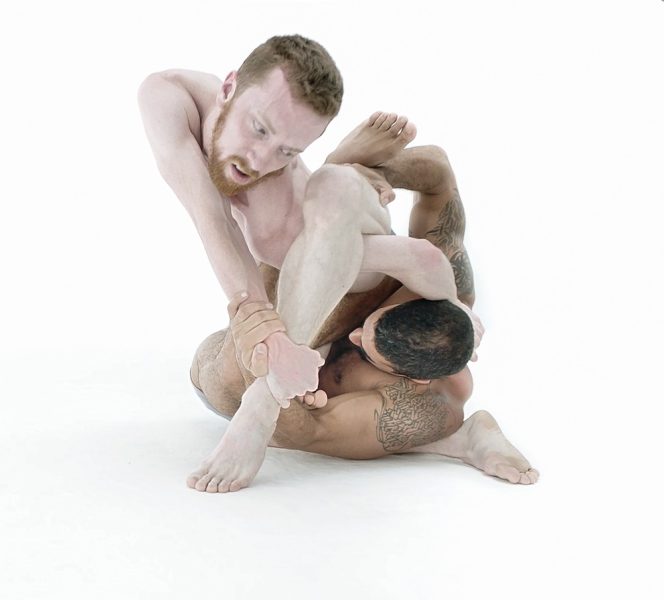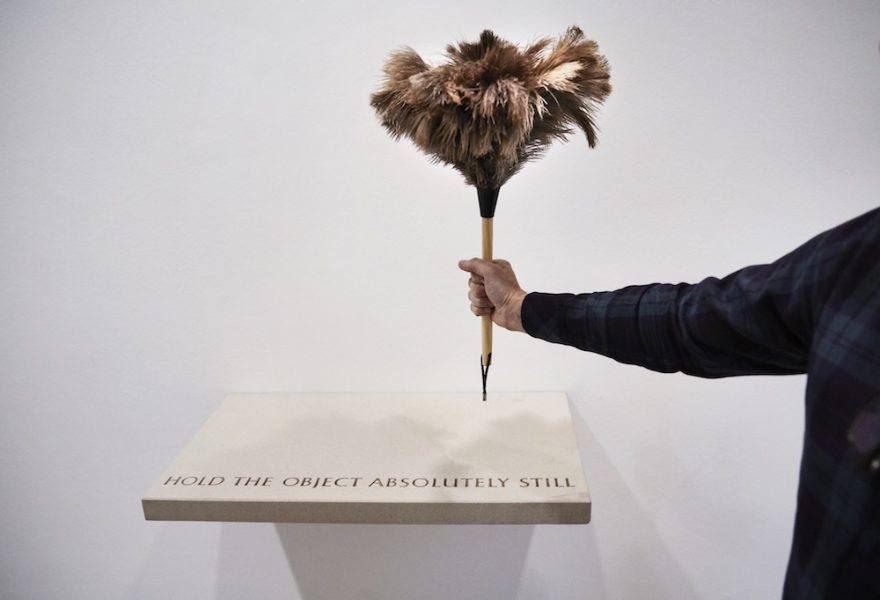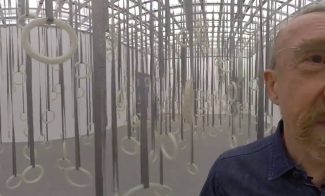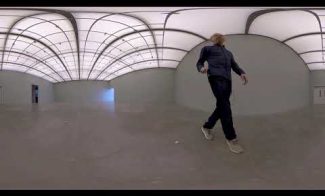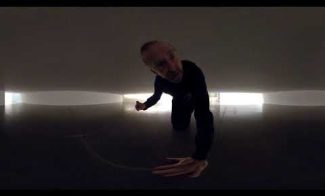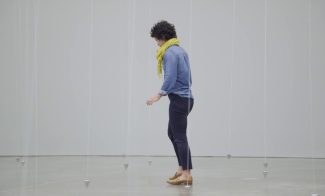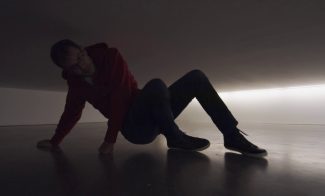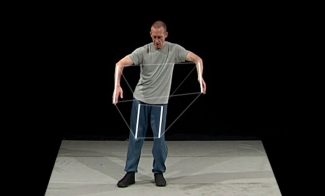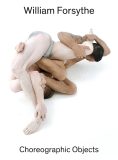The ICA presents the first comprehensive American exhibition of performative objects, video installations, and interactive sculptures of the internationally celebrated choreographer William Forsythe.
World renowned, Forsythe is counted among the foremost choreographers of our time. For over four decades he has created productions that redefine classical ballet’s vocabulary, and his groundbreaking approach to choreography, staging, lighting, and dance analysis has influenced countless choreographers and artists. Since the 1990s, parallel to his stage productions, Forsythe has developed installations, sculptures, and films that he calls Choreographic Objects. Blurring the lines between performance, sculpture, and installation, his Choreographic Objects invite the viewer to engage with the fundamental ideas of choreography. These site-responsive, interactive works are designed to stimulate movement from visitors through interactions with kinetic sculptures, video projections, and architectural environments. The exhibition features large-scale installations, including several works developed for the ICA. Via the artist’s instructions for action posted on the wall next to the works, visitors are invited to move freely through the performative exhibition and generate an infinite range of individual choreographies.
William Forsythe: Choreographic Objects coincides with Forsythe’s five-year residency at the Boston Ballet, providing audiences with instrumental insight into his pioneering choreographic work across different platforms. Catch a new world premiere in Full on Forsythe March 7–17, 2019.
The exhibition is accompanied by a richly illustrated publication featuring writers from the disciplines of both dance and art.
Timed Tickets
Timed tickets are required on weekends, February vacation week (Feb 18-21), and President’s Day in order to ensure an enjoyable experience for all. Tickets will be available on site only on a first-come, first-served basis. Tickets are limited and do sell out. We recommend arriving early on weekends or visiting during the week to secure tickets.
ICA Members do not need a timed ticket, and are always guaranteed entry into the exhibition. Become a member today!
Admission is free for youth 17 and younger, but tickets are still required.
Please note: timed tickets do not guarantee that there will not be wait times for certain artworks.
Guidelines
We ask that you engage in the works in William Forsythe in a way that promotes your own safety, is mindful of others’ experiences and safety, and respects the safety of the artwork. Note that all participation is voluntary and at the visitor’s own risk. The ICA will not assume responsibility for any injury, loss, or damage incurred.
− Please remove coats and bags before entering interactive works of art.
− No running or jumping.
− Please follow the artist’s guiding instructions, posted near the artworks, on how to participate with each piece.
The Fact of Matter
Artist’s instructions: PLEASE TRAVERSE THE SPACE USING ONLY THE RINGS.
− Participation time in this work may be limited to 5 minutes during timed ticketing periods and at the discretion of gallery staff. Eight visitors may participate at one time.
− Minors 12 years and under must be monitored by an accompanying adult.
− The Fact of Matter is not recommended for children younger than 6. Participation for children younger than 6 is at the discretion of accompanying adults and with close supervision only.
Nowhere and Everywhere at the Same Time, No. 3
Artist’s instructions: PLEASE ENTER, AVOIDING ANY CONTACT WITH THE PENDULUMS.
− No more than 10 visitors may actively engage at one time.
− For safety reasons, wheelchairs, strollers, and children younger than 3 may not enter the work.
− If you get twisted in a pendulum, please detangle yourself carefully so the pendulum remains in place. If you need help, Visitor Assistants are available in the gallery to assist you.
Video
While recording video is not allowed in other parts of the ICA, the recording of non-video artworks and experiences is allowed within this exhibition.
Go deeper
This exhibition William Forsythe: Choreographic Objects invites visitors to interact with a variety of objects and environments in unexpected ways. Below are a few frequently asked questions.
Can I touch the work?
In most cases, yes! Participants are invited to interact with many of the artworks on view according to the artist’s instructions, which are provided on labels next to the artworks. Each label also includes interpretive descriptions and a symbol indicating whether it is okay to touch the work. We kindly ask that visitors do not touch the video screens and projectors.
Can I participate physically without a dance background?
Yes! Forsythe believes choreography is for everybody, not just those with a dance background. He also believes choreography can arise anywhere, not just on the theater stage. For Forsythe, dance and choreography are different and can exist independently of each other. As he notes, “Choreography is not necessarily bound to dance, nor is dance bound to choreography, for that matter—you can just get up and dance.”
What If I am not able to interact with all the works?
There is no “right way” to interact with Choreographic Objects. Each visitor will approach the works differently and, in the process of trying to solve the problems they pose, may gain a new understanding of movement or of their body. We encourage visitors of all ages and abilities to interact with the works however they wish—whether through physical interaction, observing others, or considering the range of experiences presented on tablets within the galleries. If you visit with friends or family, you might try some of the interactive works together and talk about your experiences—you may find that they vary greatly.
Are these works appropriate for kids?
Yes! Many kids will love interacting with the Choreographic Objects. In fact, children often intuitively embody the trial-and-error processes of action-based knowledge that Forsythe is exploring. We request that parents and caretakers determine if their child can participate physically and oversee and remain with children while they interact with the works. Two works have age restrictions: For The Fact of Matter, minors 12 and under must be monitored by an accompanying adult, and the work is not recommended for children younger than 6—participation for children younger than 6 is at the discretion of accompanying adults and with close supervision only. For safety reasons, children younger than 3 may not enter Nowhere and Everywhere at the Same Time.
Some of these works are difficult or impossible to do. Why?
Ideas of physical limitation, the illusion of weightlessness, the productivity of failure, and the heroism of persevering in difficult situations have been steadfast concerns of Forsythe on stage and beyond. In many Choreographic Objects, participants are compelled to consider both the body’s physical capacities and its limitations as part of his investigation of action-based knowledge. For him, trial and error remains a productive means of learning. Some of the works are indeed nearly impossible; visitors are encouraged to attempt and experience the works however they wish.
Can I take video of these artworks?
Although video recording is typically against ICA policy, it is allowed within William Forsythe: Choreographic Objects, with the exception of video works. We encourage you to share your experience of the work and appreciate your considering other museum visitors by taking video in an unobtrusive manner.
Additional background
William Forsythe was born in New York in 1949, and resides in Vermont. Trained in classical ballet in Florida and New York, Forsythe joined the Stuttgart Ballett in 1973 and went on to direct the Ballett Frankfurt for twenty years. He directed the smaller, more specialized Forsythe Company, in Frankfurt and Dresden, from 2005 to 2015. His Choreographic Objects have been exhibited globally in venues such as Tate Modern’s Turbine Hall, the Venice and Sydney Biennales, La Villette/Grande Halle, Paris as part of Festival d’automne, and museums such as Wexner Center for the Arts, Columbus, Ohio, Museum fur Moderne Kunst, Frankfurt, and Hayward Gallery, London. He has received numerous awards and in 2010 was honored with the Golden Lion for Lifetime Achievement at the Venice Biennale.
